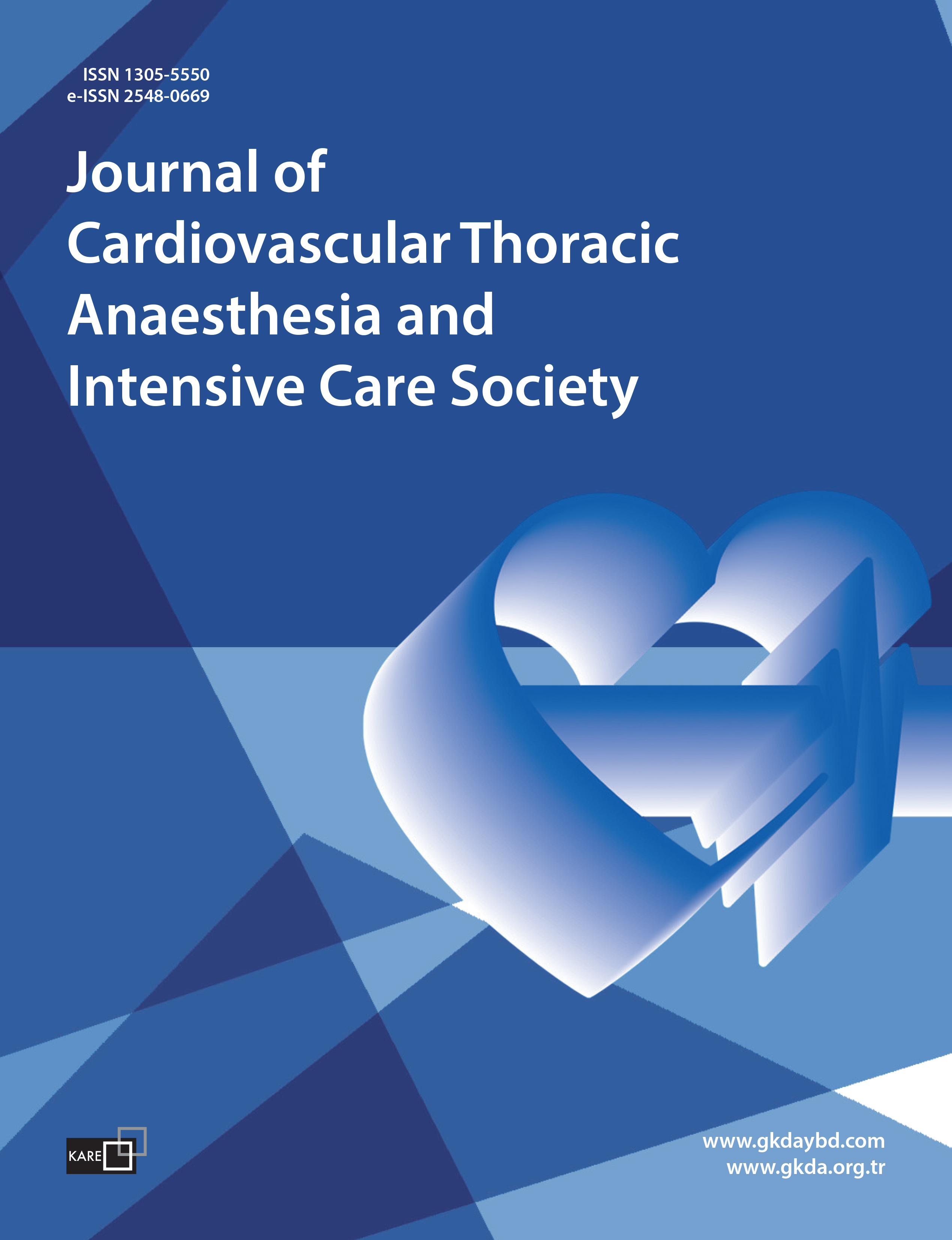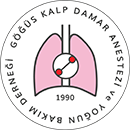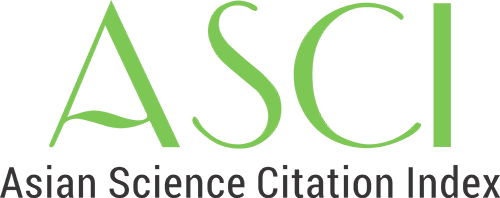

Volume: 27 Issue: 3 - 2021
| 1. | Cover Page I (449 accesses) |
| 2. | Editorial Consultants Pages II - III (424 accesses) |
| 3. | Contents Page IV (384 accesses) |
| 4. | Publication Policies and Writing Guide Pages V - X (650 accesses) |
| RESEARCH ARTICLE | |
| 5. | Morbidity and Mortality Markers in Elderly Patients with Cardiovascular Surgery Hülya Yiğit Özay, Nevriye Salman, Zeliha Aslı Demir, Eda Balcı, Sumru Sekerci doi: 10.5222/GKDAD.2021.70783 Pages 183 - 191 (596 accesses) Introduction In recent years, as a result of increased average longevity, the number of elderly patients being hospitalized has been increasing. Today, although many parameters are used to determine the prognosis of hospitalized patients, more specific information about elderly patients is required. This study aims to investigate the effect of preoperative and postoperative parameters on postoperative complications and mortality among patients aged 65 and over who underwent cardiovascular surgery. Methods Demographic data, preoperative and postoperative hemoglobin, neutrophil/lymphocyte ratio, mean platelet volume, erythrocyte distribution width, platelet, glucose, urea, creatinine, albumin values and postoperative data were recorded. Results When the preoperative risk factors for postoperative complications and mortality were evaluated, low preoperative hemoglobin and albumin values and high blood urea and glucose levels were statistically significant (p <0.005). Low postoperative hemoglobin, thrombocyte and albumin values, and high glucose, urea and creatinine values were found to be significant markers of postoperative complications (p <0.005). When preoperative risk factors were evaluated in terms of postoperative 30-days mortality, low preoperative hemoglobin and albumin, high urea value, low postoperative hemoglobin, platelet and albumin levels, and high glucose, urea and creatinine values were statistically significant (p <0.005). Conclusion We believe that closely monitoring the nutritional status of elderly patients, providing them with dietary supplementation for lacking parameters, and keeping blood glucose, urea, and creatinine at optimum levels could help us to decrease hospital stay, mortality-morbidity, and total economic cost. |
| 6. | The Effect of Low- Flow Anesthesia on Hemodynamic Parameters and Gas Consumption in Single Lung Ventilation Fatih Doğu Geyik, Yucel Yuce, Kutlu Hakan Erkal, Banu Cevik, Kemal Tolga Saracoglu doi: 10.5222/GKDAD.2021.45722 Pages 192 - 200 (1259 accesses) Introduction: We aimed to compare the effects of low and medium high flow anesthesia on hemodynamic parameters, blood gas values and gas consumption in patients undergoing single lung ventilation. Methods: We studied 40 patients over 18 years of age within ASA I-III group who underwent elective thoracic surgery by single lung ventilation. The patients were intubated double-lumen tube (DLT) following induction of anesthesia. We divided the patients into two groups randomly. In Group 1, 1L/min (80% oxygen+20% air) 4-6% desflurane; in Group 2, 2L/min (80% oxygen+20% air) was applied. Peripheral oxygen saturation, end-tidal carbon dioxide levels, heart rate, invasive blood pressure values, tidal volume, respiration rate, FiO2, fresh gas flow rate values during single lung ventilation in both groups single lung ventilation was recorded. Arterial Blood Gas analysis was performed with 1 hour intervals. The amount of desflurane used at the end of single lung ventilation was monitored by anesthesia device. Results: Desflurane consumption was significantly lower in Group 1 (55.3±18.4 vs. 84.9±37.6,p=0.003). EtCO2 was found to be statistically significantly lower in Group 2, especially between 30 and 75 minutes, and systolic, diastolic, and mean arterial pressure between 45 and 120 minutes. There was no significant difference between the groups about NIRS. Only in both left and right NIRS there was a significant elevation in group 1 at 120 minutes (p=0.08 and p=0.06, respectively). Discussion and Conclusion: Low flow with desflurane with appropriate equipment and close monitoring can be safely applied without side effects. |
| 7. | The Effect of Preoperative Ultrasonography Imaging Method on Success in Patients with Thoracal Epidural Procedure Simge Kurum, Selda Sen, Ozum Tuncyurek, Imran Kurt Omurlu, Yaşam Umutlu doi: 10.5222/GKDAD.2021.73645 Pages 201 - 209 (713 accesses) Aim: To compare the measurement of skin-epidural distance with the depths measured by preoperative ultrasonography and computed tomography in patients with epidural anesthesia at the lower thoracic levels. Also to examine the correlation of these depth measurements with anthropometric values. Method: Prospective, randomized controlled study. 96 ASA I-III patients aged 18-80 who underwent epidural anesthesia for elective urological and thoracic surgery. Patients undergoing epidural anesthesia were randomized and divided into three groups (T9-10, T10-11, T11-12 groups).Hemodynamics, neck and waist circumference, BMI, Skin-spinous process, skin-ligamentum flavum depth were measured with USG and CT, the needle depth was measured after precedure. Results: The skin-lig.flavum measurement measured by USG was statistically shorter than the skin-lig.flavum measurement measured by CT and the epidural needle length for all levels (p<0,001). The distance between the skin-lig.flavum measured by CT was statistically shorter than the needle length measurement only in the T9-10 group. A correlation was found between needle length and anthropometric data (BMI, neck and waist circumference) at all levels, and correlation was found between same anthropometric measurements at all levels with USG and CT measurements. Conclusion: With this study, it is shown for the first time in the literature that ultrasonography, CT and anthropometric measurements such as BMI, neck and waist circumference may be useful to estimate the skin-epidural depth before the epidural procedure at the lower thoracic levels (T9-12). |
| 8. | An Outbreak of Urinary Tract Infections due to Myroides Spp in Adult Intensive Care Unit: Risk Factors and Control Procedures Şerife Gökbulut Bektaş, Ayhanım Tümtürk, Ahmet Gökhan Akdağ, Seval İzdeş doi: 10.5222/GKDAD.2021.46704 Pages 210 - 215 (1916 accesses) Microorganisms of the Myroides genus are common in the environment, especially in water but rarely seen as an infectious agent in humans. It was described uncommonly in immunocompetent patients. Their treatment is challenging due to their resistance to many antibiotics. Herein, we report the Myroides spp-associated nosocomial urinary tract infection outbreak occurring in tertiary intensive care. A total of 9 Myroides spp reproductions in 7 patients were included in the study between July 2019 and December 2019. For Myroides species known to have multi-drug resistance, response to the combined treatment of ciprofloxacin and rifampicin was achieved in 5 out of 7 patients. We would like to point out that poorly controlled diabetes can cause outbreaks. Also, ciprofloxacin and rifampicin may be effective options in treatment. |
| 9. | Pneumothorax in Coronavirus Disease-19 Patients: A Retrospective Case Series Mustafa Bıçak, Fikret Salık doi: 10.5222/GKDAD.2021.03264 Pages 216 - 222 (1217 accesses) Aim Pneumothorax may develop secondary to alveolar damage and barotrauma in Covid-19 patients. In this study, we aimed to present Covid-19 patients who developed pneumothorax when we followed up in the intensive care unit, in the light of the literature. Methods Eleven patients among 2680 patients tested positive for Covid-19 in the PCR test, who were found to have developed pneumothorax in the radiologic examination were included in the study. The data were taken from patient follow-up forms and electronic medical records. Demographic data, blood and biochemical parameters, blood culture results, pneumothorax development time and location, form of pneumothorax treatment, mortality and time were recorded. Results The frequency of pneumothorax was found to be 0.41%. The most common complaint was dyspnea. It was observed that 9(81.8%) patients had comorbidity and the most common comorbidity was hypertension. It was determined that 3 patients(27.2%) did not smoke, 4 patients(36.3%) were active smokers, and 4 patients(36.3%) were ex-smokers. The mean age was 69±14.8years, the APACHE II score were 18.8±8.7, the female/male ratio was 3/8, and the pneumothorax development time was 10.7±11.8days. Pneumothorax developed in 3 patients(27.27%) on noninvasive mechanical ventilation and 8 patients(72.7%) on invasive mechanical ventilation. The mean length of stay in the intensive care unit was 21.6±26.5days. It was found that 10 patients(90.9%) died and the mean mortality duration was 19.5±27.0days. Conclusion In Covid-19 infection, lung protective ventilation strategies should be adopted and it should be known that the development of pneumothorax is a late complication that increases mortality and morbidity. |
| CASE REPORT | |
| 10. | Anesthesia Management in Congenital Heart Surgery in a Patient with Liver Transplantation Fatma Ukil Işıldak, Yasemin Yavuz, Ömer Faruk Şavluk, Ufuk Uslu doi: 10.5222/GKDAD.2021.97720 Pages 223 - 225 (1162 accesses) Liver transplantation has been used successfully in adult and pediatric patients for many years. As the survival rates of transplant patients increase, the rates of comorbidity and nontransplant surgery also increase. In a 20-year-old male patient, who underwent open heart surgery 13 years ago for familial hypercholesterolemia and had liver transplantation 3 months later after cardiac surgery, was planned for aortic root enlargement operation due to aortic valve stenosis. In this study, our experience of anesthesia in a patient with liver transplantation is presented. |
| 11. | Throracic Aortic Dissection Concomitant Multitrauma: A Case Report Işıl Deringöz, İsmet Topçu, İlknur Bahar Başkavas, Tülün Öztürk, Güvenir Okçu doi: 10.5222/GKDAD.2021.44711 Pages 226 - 229 (622 accesses) Aortic injuries are seen in the isthmus part of the aorta at a rate of 90-95% after blunt trauma to the thorax. Post-traumatic lesions in the aorta; simple contusion, intramural hematoma, dissection due to rupture or pseudoaneurysm. In most of the patients, pain in the anterior chest wall, back pain, dyspnea, cough, hoarseness, hypotension, maladaptive pulse, shock, coma may be seen, while approximately of them are asymptomatic and / or overshadowed by other symptoms associated with multitrauma. These injuries are caused by acceleration and deceleration mechanisms in the aorta. In treatment, endovascular repair is a good alternative to open surgery. In our case; We aimed to present our approach to thoracic aortic dissection and endovascular intervention in a 34-year-old multitrauma patient who was brought to our emergency department after a fall from a height of approximately 10 meters. Keywords; Aortic dissection, traumatic aortic injury, endovascular intervention, TEVAR (thoracic endovasculer aort repair) |
| 12. | Experience Of Outpatient Anesthesia in a Pediatric Patient With Cutis Laxa Type-IC Syndrome Yasemin Yavuz, Fatma Ukil, Seda Arısüt, Ömer Faruk Şavluk doi: 10.5222/GKDAD.2021.35683 Pages 230 - 232 (1580 accesses) Cutis Laxa Type 1C, also known as Urban-Rifkin-Davis syndrome, is an autosomal recessive disease characterized by common connective tissue disorder in early childhood. In this study, our experience of outpatient anesthesia with sedation in a child with Cutis Laxa is presented. |

















